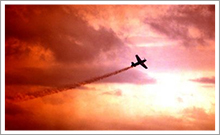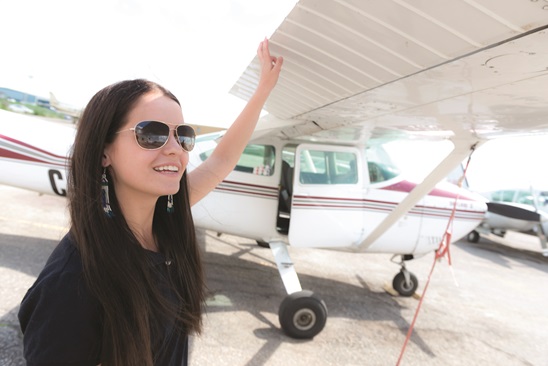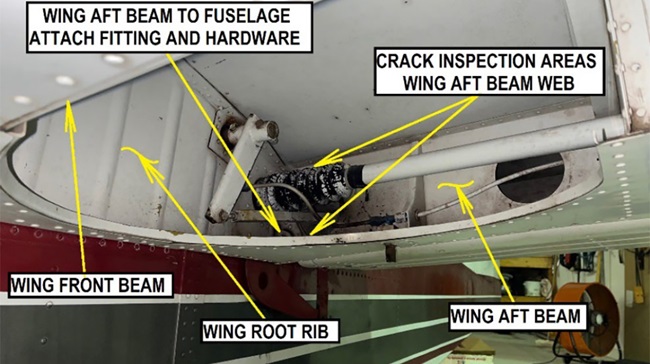The August 20, 2010, issue of 'AOPA ePilot Flight Training Edition' e-newsletter
| ||||
| | FT News | INSIDE AOPA | TRAINING PRODUCTS | FINAL EXAM | |||
TRAINING TIPsHow much brake?
How you evaluate that question may determine how your designated examiner evaluates you. The decision depends on runway length and the landing technique in use. But even on a long, paved runway, you may need to exit at a designated taxiway, if the tower requests you do so because of traffic to follow you, for example.
On the normal rollout, first decelerate with aerodynamic braking. This extremely effective method happens to be the reason why your instructor exhorts you to keep the yoke fully back after touchdown. How does aerodynamic braking work? “Before the rolling aircraft is firmly planted on its wheels, the same drag induced by flying at a high angle of attack helps to slow the aircraft on the ground. Lowering the nose at this stage would cause the aircraft to accelerate, making control on the ground tricky,” explained the Aug. 26, 2005, “ Training Tip: Aerodynamic braking.”
At the other end of the spectrum, the short-field landing may call for aggressive braking. The short-field approach and landing task in the Private Pilot Practical Test Standards requires that the pilot apply “brakes as necessary to stop in the shortest distance consistent with safety.” By comparison, note that the normal and crosswind landing task description in the PTS does not specifically mention the brakes. Trainers that lack steerable nosewheels also employ differential braking to maintain directional control when the rudder loses effectiveness during the rollout.
The April 2010 Flight Training “ Accident Report” column examined several surface mishaps and extracted these tips about footwork: “Tighten your tolerances for when to apply corrective rudder on takeoff and landing runs (and with braking when rudder is not effective). Make it a habit to pin that aircraft to the runway centerline! If that stripe ends up under a wing tip after the rolling and thumping has ended, ask yourself (or your CFI) why and be sure that you arrive at the right answer.”
Know the aircraft, the technique, and the demands of the situation before you tap the brakes. YOUR PARTNER IN TRAININGA great benefit of AOPA membership is that it can easily pay for itself if you take advantage of all the discounts. One such discount is on car rentals, where members get things such as free upgrades, free days, and reduced rates. Hertz even offers a free membership to the #1 Club Gold. Check out these and many other deals online.
Did you know that student pilots who join AOPA are three times more likely to complete their flight training? Membership includes unlimited access to aviation information by phone (800/USA-AOPA, weekdays from 8:30 a.m. to 6 p.m. Eastern time) or from AOPA Flight Training Online or AOPA Online. If you're not already a member, join today and get the pilot's edge. Login information is available online. FLIGHT TRAINING NEWSGirls With Wings scholarships closing soonAspiring female aviators looking for some financial support should apply to the fourth annual Girls With Wings scholarship. The group is awarding two $1,000 grants to a woman who has soloed, but not yet received her certificate. Applicants must submit a short essay and a photo. The deadline for applications is Aug. 31. Calif. flight schools closer to reprieve on costly regFlight schools in California could get a stay from the California Private Postsecondary Act of 2009, a law that has had unintended consequences. The act, which was intended to protect students from unscrupulous businesses practices of some private educational providers, went into effect Aug. 1. The act requires flight schools to pay multiple new administrative fees and open their books to regulators. AOPA advised flight schools to file for a waiver from the act in advance of Aug. 1. Individual flight instructors, however, are not affected by the act and do not need to take any action, according to AOPA’s review of the law. Read more >> US Aviation takes over training contractMore than 60 flight students from China have been given a reprieve, thanks to Denton, Texas-based US Aviation. The students had previously been left without a school after Wright Flyers Aviation in Hondo, Texas, closed. As part of the deal, US Flight Academy, a subsidiary of US Aviation, will purchase the assets of Wright Flyers Aviation, and use the former school’s facilities in Hondo. Wright Flyers Aviation closed abruptly a few weeks ago, after moving to Hondo in April. According to news reports, the Chinese airline that was sponsoring the training failed to pay $1 million in fees to Wright Flyers. Read more >> Inside AOPAAvoid wake turbulence ridesYou wouldn’t willingly fly through a tornado, would you? Then, beware of an equally powerful force lurking around airports—wake turbulence generated by larger aircraft and heavy jets. Test your understanding of wingtip vortex paths and danger zones for arriving and departing airplanes. What would you do if you suspect the onset of wake turbulence on final approach? Take this safety quiz, underwritten by the AOPA Insurance Agency. ‘Know Before You Go’ challengeWhen you launch on a cross-country flight or just a quick hop to a nearby airport, it’s critical to understand the airspace in your path. But there are no road signs in the sky, so you’ll need to figure things out before you take off. With the AOPA Air Safety Foundation’s comprehensive online course Know Before You Go: Navigating Today’s Airspace, you’ll cover charts, airspace basics, special-use airspace including restricted and prohibited areas, temporary flight restrictions, and basic flight planning. This course qualifies for AOPA Accident Forgiveness and the FAA Wings program. Take the challenge >> Safety is the name of the game at AOPA Aviation SummitIt’s been said that “a good pilot is always learning,” and this year at AOPA Aviation Summit held in Long Beach, Calif., you can choose from more educational forums than ever before. With topics ranging from “Fast Track to Your Pilot Certificate” and “Mastering Takeoffs and Landings,” to “How to Pass any Checkride” and “Night Flying Safety: What Your CFI Didn’t Teach You,” the forums offer something for every skill level. So whether you’ve just passed your checkride or you’re looking for tips to polish your skills, stop by one of the many forums held multiple times each day, and listen to top aviation experts, ask that burning question you’ve always wanted to know, and take a step toward becoming a safer, more proficient pilot. Satisfy your information needs at AOPA AirportsWhat are the flight schools at PDK? Is there a GPS approach at Cleburne Municipal? If I fly into KAKH, will I be able to get a cab into town? I’m meeting a friend for Saturday lunch—which airports have a restaurant on the field? Many pilots have come to rely on the information AOPA Airports provides for their flight planning. Recently redesigned, AOPA Airports is a tremendous member benefit, and access will continue for free online to AOPA members. However, some pilots still prefer a hard copy of the directory in the cockpit or to browse through at home. For those members, AOPA will print a limited number of AOPA Airports in book format. Orders are being taken now for AOPA Airports, the book, and may be made online. TRAINING PRODUCTSJeppesen saleJeppesen is having a sale through its JeppDirect online store. Students can save up to 20 percent off items such as a current FAR/AIM, the company’s complete private pilot training kit, and more.
Note: Products listed have not been evaluated by ePilot editors unless otherwise noted. AOPA assumes no responsibility for products or services listed or for claims or actions by manufacturers or vendors. FINAL EXAM
Question: What are some of the privileges and limitations of the sport pilot certificate?
Answer: FAR 61.315 spells out in detail the privileges and limitations of the sport pilot certificate. A few of the privileges include the ability to carry one passenger and share the expenses of the flight. There is no limit on how far an individual may fly a light sport aircraft. And perhaps one of the most important privileges is the ability to fly without an FAA airman medical certificate, provided the individual has a current and valid U.S. driver’s license, and complies with all limitations on that license. There are some limitations, and they include no night flight, no flying without visual contact with the ground, and no flying in Class B, C, or D airspace without additional training and the appropriate logbook endorsements. For more information on the sport pilot and light sport aircraft rule, read the subject report on AOPA Online.
Got a question for our technical services staff? E-mail [email protected] or call the Pilot Information Center, 800/872-2672. Don’t forget the online archive of “Final Exam” questions and answers, searchable by keyword or topic. what’s new onlineThe practical sideIn training it’s sometimes difficult to see through the maneuvers and book learning to understand why we practice what we do. But there are always practical applications for the skills, something Flight Training Deputy Editor Ian J. Twombly found out last week. Check out the Flight Training blog to find out what happened. Picture Perfect
AVIATION EVENTS & WEATHER To include an event or to search all events in the calendar, visit AOPA Online. For airport details, including FBO fuel prices, see AOPA Airports. Flight Instructor Refresher ClinicsThe next AOPA Air Safety Foundation Flight Instructor Refresher Clinics are scheduled in Allentown, Pa., Aug. 28 and 29; Sacramento, Calif., and Baltimore, Md., Sept. 11 and 12.; Colorado Springs, Colo., Richmond, Va., and Seattle, Wash., Sept. 18 and 19; Phoenix, Ariz., Sept. 25 and 26. For a complete schedule, see AOPA Online.
Can’t make it in person? Sign up for the CFI Refresher Online. AOPA Air Safety Foundation Safety SeminarsAOPA Air Safety Foundation Safety Seminars are scheduled in Germantown, Tenn., Aug. 30; Nashville, Tenn., Aug. 31; and Maryville, Tenn., Sept. 1; Newton, Mass., Sept. 7; East Hartford, Conn., Sept. 8; Morristown, N.J., Sept. 9; Wichita, Kan., and Sioux Falls, S.D., Sept. 13; Oklahoma City, Okla.,and Pierre, S.D., Sept. 14; Little Rock, Ark., and Rapid City, S.D., Sept. 15; Rochester, Minn., and Reno, Nev., Sept. 20; Sacramento, Calif., and Cedar Rapids, Iowa, Sept. 21; San Jose, Calif., and Bellevue, Neb., Sept. 22; Olathe, Kan., Sept. 23; Mesa, Ariz., St. Louis, Mo., Pittsburgh, Pa., and Ft. Worth, Texas, Sept. 27; Springfield, Mo., Summerdale, Pa., and Houston, Texas, Sept. 28; Albuquerque, N.M., Allentown, Pa., and San Antonio, Texas, Sept. 29; and King of Prussia, Pa., and Austin, Texas, Sept. 30. Topics vary—for details and a complete schedule, see AOPA Online. | Got news? Contact ePilot. Having difficulty using this service? Visit the ePilot Frequently Asked Questions now at AOPA Online or write to [email protected]. |
| Member Tools : Send feedback | Update member profile | Change email address | Unsubscribe | ePilot Archive Editorial Team: ePilot Flight Training Editor : Ian Twombly | ePilot Editor: Sarah Brown | Contributor: Alton Marsh |

 The Aug. 13 “
The Aug. 13 “ 


